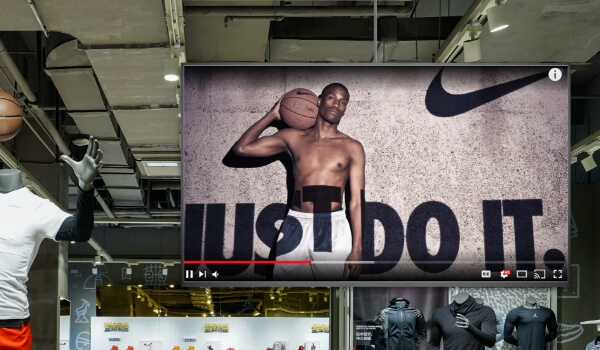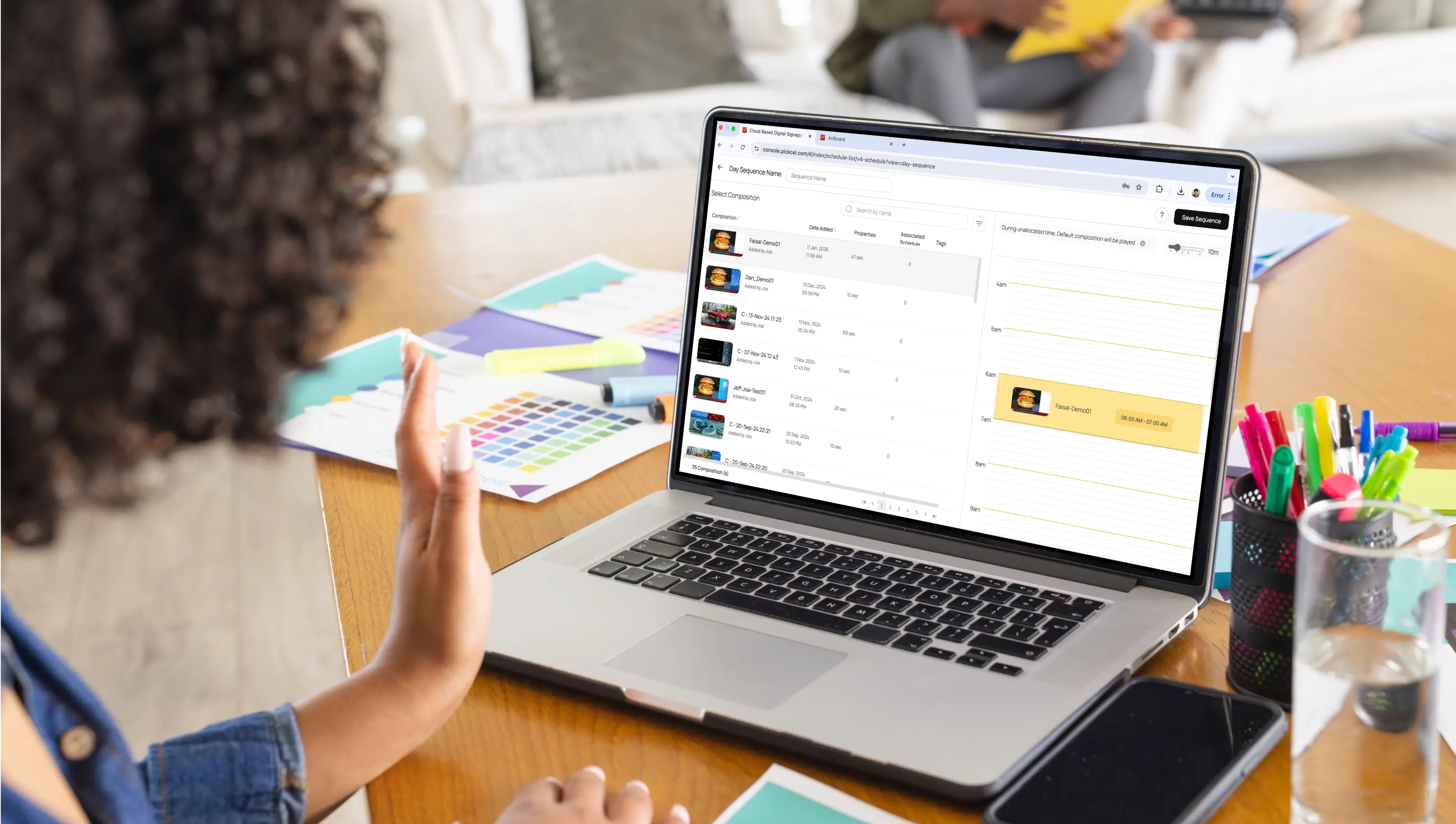
Nov 30 2022
9 min read

Over the years, digital signage has become an integral part of many businesses. Whether it is for advertising products or making the customer experience superior, the omnipresence of screens is palpable.
The evolution of digital signage technology has opened up new avenues for creating immersive experiences, helping drive customer engagement, and, boost business outcomes. In 2024, a robust digital signage strategy is the need of the hour. It is more than just placing screens; it’s about crafting experiences, effectively conveying messages, and engaging with your audience at a deeper level.
Digital signage is one of the most versatile digital assets for a business. Yet, most organizations fail to mine the technology’s full potential. The reason?
They have no digital signage strategy in place.
What inspired us to write this blog is that many organizations don’t even realize that they need a digital signage strategy in the first place. They spend big bucks on sleek, efficient hardware but end up using these precious tools to display prosaic and often outdated content.
The following are some of the most compelling reasons why every business should have a well-defined digital signage strategy:
**To maximize the effectiveness of your digital screens**
The countless benefits of digital signage serve as the main reasons you choose it as a powerful marketing tool for your business, no doubt about that. But you can’t enjoy those benefits unless your screens perform at their optimum potential.
**To keep the design, marketing & sales team in sync**
When things are planned, you can get rid of the confusion and queries from different departments. The design team knows what content to produce, and the marketing team has it all under control with the performance metrics presets. And you, as the business owner, save time and budget on the backend.
**To avoid content errors**
68% of US consumers decide about the quality of a business and its products or services based on the content on digital signage. So, you are actually making a grave mistake by showing outdated, irrelevant, or erroneous content on your screens.
Your screen media needs to be focused and flawless. And that is only achievable with an orchestrated digital signage content strategy.
**To avoid missing opportunities**
It’s raining outside, and you know your customers aren’t going anywhere for the next half an hour. Take advantage of the opportunity by showing the special monsoon offers and discounts.
Having a digital signage strategy doesn’t necessarily mean always having a pre-thought-out program. It simply means that your staff has the guidelines to take ad-hoc actions.
**To have a paradigm to judge your efforts & results**
You can’t quantify and assess things that you can’t trace. Random and unprepared efforts are nearly as inconsequential as no effort. A digital signage strategy allows you to have a model to monitor your results and proceed accordingly.
Before you put up anything on your screen, before you even buy the screen(s) for your business, answer these questions.
The demography and the psychology of your target audience are the foremost data you need.
Decide what age group comprises the largest segment of your consumers. The standard age categorization is:
| Age (in years) | Generation |
|---|---|
| 77 – 94 | Post war |
| 68 – 76 | Boomers I |
| 58 – 67 | Boomers II |
| 42 – 57 | GenX |
| 26 – 41 | Millennials |
| 10 – 25 | GenZ |
Decide the sex of your consumers. Of course, there are many obnoxious males-versus-females stereotypes. But, beyond that, there are some honest differences between the consumer behavior of these two genders. For example, male shopping patterns reveal to be more utilitarian (get what you need) while female consumer patterns tend to be more hedonic (explore and see what you need).
The answer to this question is hidden in the answer to the previous question. The needs of your consumers are directly related to their demography and identity.
For example, a pre-teen will grab the brightest and the most colorful shoe on display. But, a middle-aged person will feel the shoe and wear it first to decide how comfortable they are.
Accordingly, you can shape your digital signage strategy. If your target audience is primarily middle-aged, you can advertise comfort more than looks.
The objective of your digital signage will be either of the following three:
To engage your audience
To make your audience perform an action
To inform your audience
Your digital signage strategy will become different for each of the above objectives.
For example, the following chart compares how each factor (screen location & content design) differs for a retail business when it wants to inform the audience and when it wants the audience to take an action.
| Objective | Screen Location | Screen content design |
|---|---|---|
| To inform (about a flash sale) | On the shop windows & at the entry gates | - Eye-catchy design - more image & less text - A countdown timer to build excitement |
| To make a customer take action (purchase a product) | Near the product shelf | - The product details highlighted - A few product reviews to build trust |
A significant consideration in your strategy is the digital signage cost. That includes the cost of hardware & software and the cost of designing the content.
If you start your digital signage network from scratch, the hardware price will be an upfront one-time investment (often, it will be a sizeable chunk of your signage cost).
Generally, the investments in screen content management software and designing content will recur monthly based on your needs. However, these costs are much less than the hardware costs.
Developing a digital signage strategy, or any strategy for that matter, is a work of research and analysis. But knowing what to research is important. Here are some activities that you need to undertake.
Is there really a way to see if your digital signage marketing campaigns bring quantifiable results?
Yes, there is.
Whether they employ digital signage or not, most businesses already use a wealth of KPIs & business metrics to assess their monthly or quarterly business. For example:
**Customer traffic:** how many customers visit your store, website, or eCommerce site each day or each month.
**Conversion rate:** Percentage of total footfall that ends up purchasing your goods & services
**Churn rate:** Percentage of customers your business fails to retain
**Inventory turnover rate:** The frequency at which a brand runs out of products and needs to replenish them.
**Cost of Customer Acquisition (CAC):** The amount of money a company has to spend to acquire a new customer in a specified time.
When developing your digital signage strategy, consider that these metrics should give you more optimistic numbers. Once you implement your plan, you can conduct a before-and-after comparison of these data and evaluate the effectiveness of your digital signage campaign.
According to digital marketing gurus — the relationship between your contnet and target audience is directly proportional. In other words, the content on your digital signage should evolve as rapidly as your audience’s interests. the more balance you strike between promotional content and content that entertains, informs, and engages, the better it would be for you as a digital signage company.
A strong digital signage strategy isn’t just about what you display, but how you manage the content. Invest in a digital signage platform that allows you to:
Proper content management ensures your digital signage remains engaging and relevant, maximizing your ROI.
Competitive SWOT analysis is one of the critical undertakings of any strategy. Make a list of businesses in your domain that are currently running a successful digital signage campaign. Observe these aspects of your competitors:
What are their top-selling products?
Are they advertising these products more often on their digital signage?
How often do they discount their products?
How do they promote their products? (do they connect emotionally with the customers or highlight product features?)
What products are they failing to sell enough? (this will give you an idea of how you can capitalize on their weak points)
Once you have done that, you will know exactly which areas you need to focus on. Here is **an example**:
**Store A** has identified the following things about its competitor **Store B**:
Store B uses 5 screens-
1 outdoor digital sign to highlight new launches
1 screen at the entry gate to play product commercials
3 screens in various aisles of the store that show product discounts
1 screen at the cash counter to display membership plans
Here's how Store A will use this data to plan its digital signage strategy:
**Deduction from Competitive Analysis:** Store B is mainly focusing on product marketing. They are not giving due attention to the customer experience.
**Action required:** Use their screens to make the customer shopping experience better.
Dedicate a screen for in-store entertainment. Play Youtube videos, show real-time traffic information, share news updates on the screen.
Store A can use Pickcel’s exhaustive resource of 60+ content apps to add infotainment on screens and make the shopping experience better than Store B.
Prompt customers to engage with the brand. Store A can add a social wall and start a hashtag campaign.
Display products on a digital product catalog. With Pickcel’s digital catalog solution, Store A can allow their customers to browse merchandise on mobile phones by scanning a QR code.

When planning a digital signage strategy, it is essential to distinguish your brand from the others. Different brands employ different voices.
Here are some examples of brands that have carved out an illustrious brand voice:
**Nike:** Inspirational
**Harley-Davidson:** Powerful and bold
**Paperboat:** Childhood and nostalgia
**McDonald’s:** Happiness and joy
**Ikea:** Minimalism and utilitarian
Your brand voice should be uniform across all your marketing channels, including digital signage.
The brand voice will determine the design factors of your digital signage media, such as color warmth, text font, model make and outfit.

Surveys reveal that 95% of customers read reviews before making a purchase.
That is why you should never fail to include user-generated content in your digital signage marketing strategy.
Here are two types of user-generated content (UGC) that you can add to your screens:
Customer testimonials
Hashtag campaigns on social media
Imagine yourself going shopping for baby products. You look at the aisle and you notice a torrent of brands selling the same product and saying the same things like No harsh chemical, Long-lasting, and cruelty-free. How do you pick one from that?
Now imagine if out of these brands, one would show its customer reviews on a digital screen. Wouldn’t it make a difference?
When brands praise their product, there is a profit-driven motive behind it. When consumers praise a brand’s name, that is perceived as genuine which is why this marketing strategy almost instantly shows results.
Your digital signage strategy should also include a detailed timeline of content publishing.
Know how Pickcel helped Arogya Ahaara mange their menus remotely Read the Arogya Ahaara case study here
Here is a crude way you can follow to prepare a digital signage content calendar unless you want to use any software:
Get a calendar and figure out the special dates like:
New Year’s Eve - January 01
Valentine’s Day - February 14
Women’s Day - March 08
St. Patrick’s Day - March 17
Labor Day - First Monday in September
4th of July - self-explanatory
Halloween - October 31
Thanksgiving - The fourth Thursday of November
Black Friday - The Friday after Thanksgiving
Cyber Monday - The Monday after Thanksgiving
Christmas - December 25
On these days, your digital signage shouldn’t remain blank or play the regular content. These are special days when you can give special sales and launch new products.
The content of your digital signage should be in sync with the spirit of the day.
Pickcel's digital signage software has an advanced scheduler that can let users plan and schedule their content on specific date & time. The content gets auto-published on the defined schedule. This makes it so much easier for you to focus on your business during those busy dates.

Trial and error is part and parcel of any strategy-making. However, we would like to point out some common mistakes businesses tend to make while planning and implementing their digital signage strategy.
If you are deploying a digital signage network for the first time, try it out with a pilot project. For example, if you have ten stores, don’t go all out and purchase the hardware and software licenses for all the ten stores. Try with one store first. This will let you figure out problems and allow you to change course without losing money.
This is another common mistake that many brands make while designing a digital signage strategy. Keep your cost budgeting such that you get more ROI.
Remember, the software is the brain of your signage. So it is always recommended to choose a powerful, feature-heavy digital signage software that will simplify content publishing and rendering.
Many businesses make the mistake of placing the screens in nooks & corners of the showroom where their customers may not even go. Screens should always be placed in high-traffic areas like:
store windows
entry gates
Action alley
Product shelves
Billing counters
Some areas you can avoid deploying screens:
Trial rooms
Exit gates
Narrow aisles
Content is king, even for digital signage. Sometimes businesses put so much effort and investment into strategizing that they forget to make the content strong.
Playing outdated content or showing mistakes in advertising can cost you dearly. It makes your brand look amateur, and that directly affects your sales.
To make your digital signage strategy powerful, you might be tempted to use several BI (Business Intelligence) tools and software. While you are always free to do that, try not to confuse and burden your staff with too much intelligence. It can lead to confusion and friction.
Whatever your digital signage strategy may be, it is important to have one. You can find a number of challenges initially, but you will always get better results with a strategy. At Pickcel, we offer various digital signage services to our clients including consultation, content services & more.
If you want to grow your business with Pickcel, contact us and we will be happy to help you out.





Nov 30 2022
9 min read

Nov 11 2022
8 min read

Oct 20 2022
5 min read

Sep 20 2022
12 min read
Take complete control of what you show on your digital signage & how you show it.
Start Free Trial Schedule My Demo